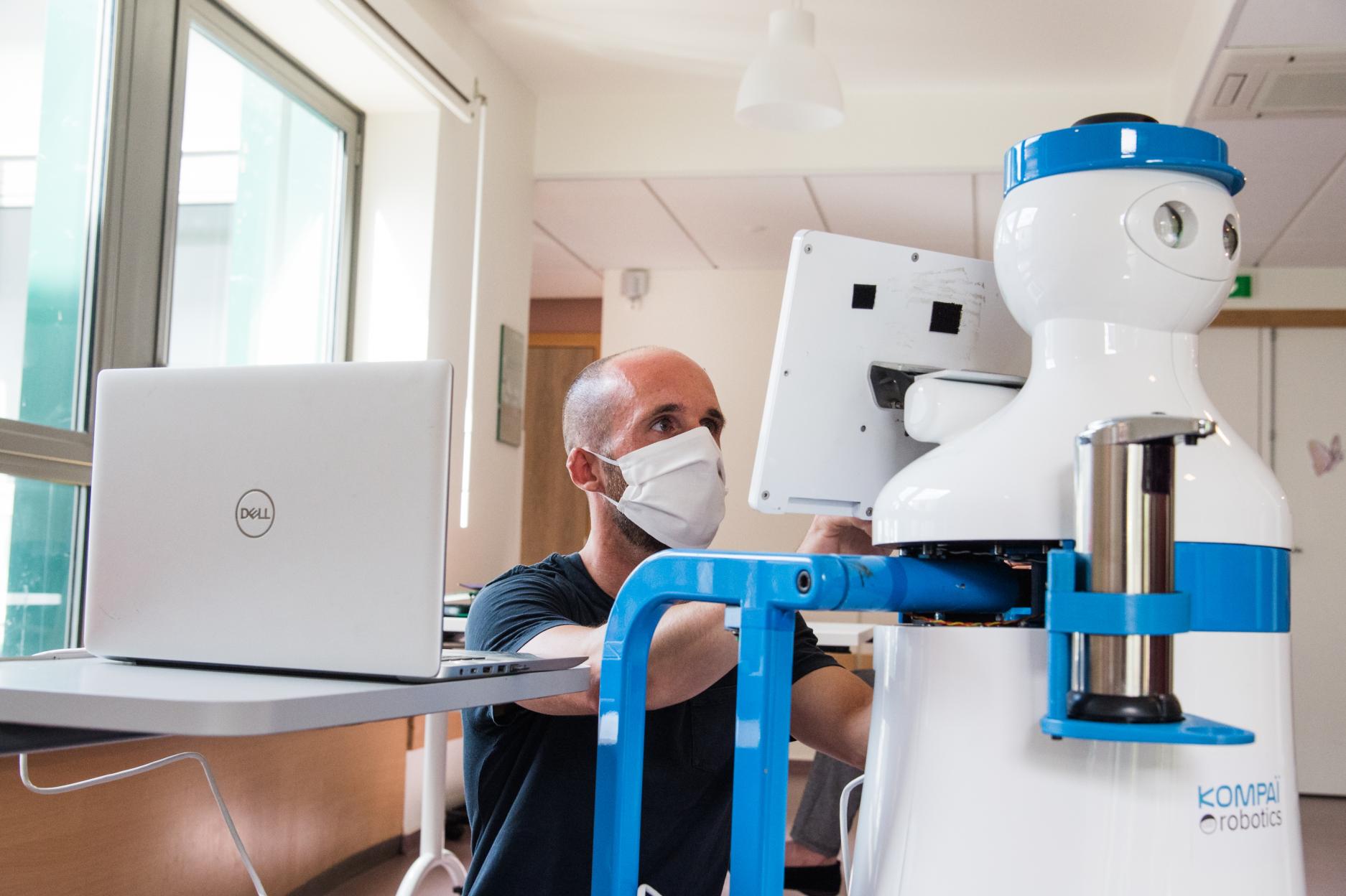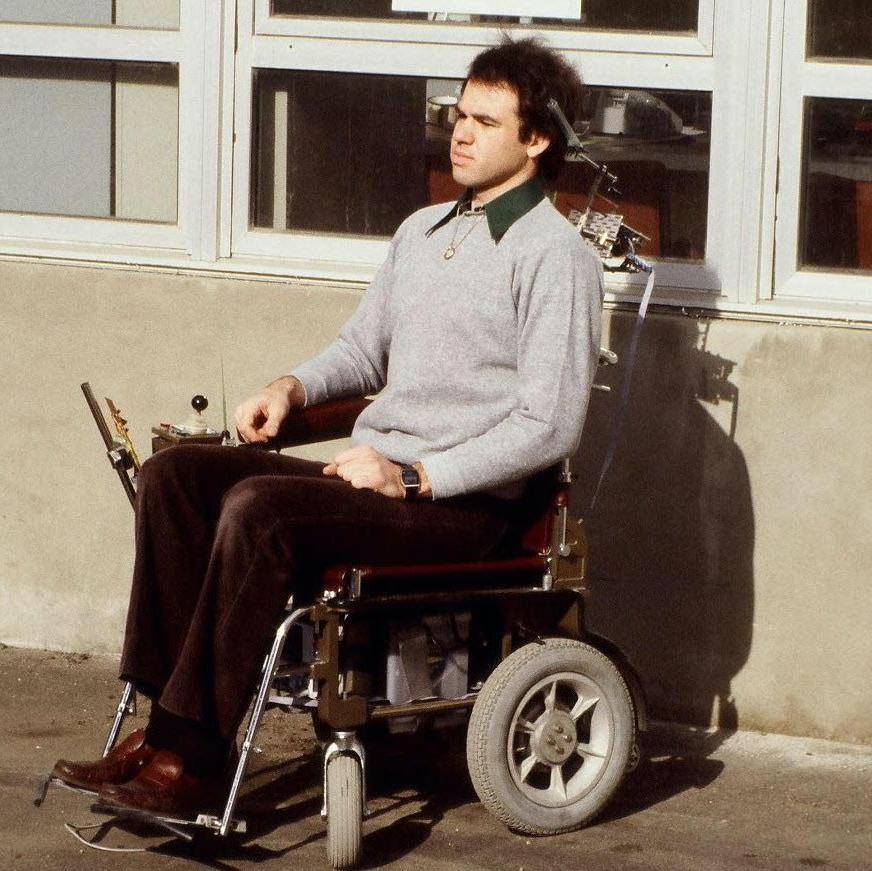How KOMPAÏ Robotics Solves Human Problems
Hustle & Cash Flow
Far from Silicon Valley, CEO Vincent Dupourqué and his 10-person team at KOMPAÏ Robotics design, build and test their latest healthcare innovation in Bidart, a small beachside town in Southwestern France. The team seeks to solve the problems of nursing homes and hospitals around the world, which are struggling to provide assistance to the rapidly multiplying number of the elderly and their families.
With decades of experience in biomedical engineering and general robotics, Vincent started KOMPAÏ Robotics in 2016 to create a solution to this crisis with a robot designed to help caregivers and patients.
Although their robot focuses primarily on assisting caregivers, Vincent and his team must work out a specific problem: how it will interact with multiple people with different goals, including the caregiver, the patient, and the patient’s family. The KOMPAÏ also functions as a companion robot, built to help seniors monitor their health, talk with friends, family, and their doctors, and even walk. In other words, these robots can also help the elderly to maintain their autonomy longer.
Developing a complex product
“The biggest challenge is that robots can do anything,” says Vincent. “We had to define a few functions that make sense. This meant we churned out 20 to 30 prototypes to eventually reach something that made sense for the end-user.”
The engineers at KOMPAÏ Robotics test it at multiple hospitals and nursing homes in the region. They don’t just test for functionality, but for emotions. Using focus groups at hospitals and other nursing homes, they have been able to define the size of the robot, its global appearance, functions, and make it acceptable to all users.
 KOMPAÏ can remind patients of when to take their medicine and how much to take, call for help in case of an emergency, and collect and store healthcare data.
KOMPAÏ can remind patients of when to take their medicine and how much to take, call for help in case of an emergency, and collect and store healthcare data.Now in its third model, you can find the KOMPAÏ at EHPAD Adarpea, a nursing home only ten minutes away from the team’s workshop. During lunch, this robot roams the cafeteria, showing a film or playing music on its screen to promote conversation among the elderly residents as they wait for their meal. This same machine can take a stroll with residents, allowing them to use it for support without the hassle of pushing the machine. For the nurses and other caregivers, KOMPAÏ can remind patients of when to take their medicine and how much to take, call for help in case of an emergency, and collect and store healthcare data.
When COVID-19 became a concern, KOMPAÏ adapted to the crisis. They created an alert to remind users to wash their hands and take other health precautions to prevent the spread.
KOMPAÏ version 3 is approaching the end of its testing phase. But the journey has been a long one. When you look at KOMPAÏ’s current selection of healthcare-based robotic caregivers with huge human-like eyes and a touch screen, it’s hard to look back at where this dream began.
Vincent started his journey towards biomedical engineering in 1975 at the Université de Technologie de Compiègne. When he joined the SPARTACUS project and developed a robot for quadriplegics, he found it both interesting and motivating. But shortly after his studies, he had to stray from healthcare robotics and pivot into industrial and military robotics engineering.
 Looking back: For his PhD, Vincent developed a system to robotize and control a wheelchair with head, for quadriplegics. The same head device was also used to control the SPARTACUS robot.
Looking back: For his PhD, Vincent developed a system to robotize and control a wheelchair with head, for quadriplegics. The same head device was also used to control the SPARTACUS robot.“The reason for shifting into general robotics was very simple. During the 80s and 90s, there was no money available for healthcare robotics. All of the funding and research went into military and industrial pursuits.”
In 1985, Vincent co-founded Robosoft, where he made a breakthrough in robotics. Robosoft designed and created the first mobile robot called the roboTER. Think of it as an earlier version of robotic sweepers, square and compact, with the ability to handle hundreds of pounds. As one of the first mobile robots dedicated to research, traces of the roboTER can be found in hundreds of other robots made by Robosoft and KOMPAÏ.
Balancing passion & finances
The dedicated engineers continued to develop and refine their robots. From robots that cleaned floors, vacuumed, fueled tanks to autonomous shuttles and unmanned ground vehicles. Their decades of research in robotics eventually allowed them to engineer robots that drive Vincent and the company today: The KOMPAÏ.
“At the beginning of the 2000s, we understood we had two directions where we could make robots that helped people. First was that we could continue with autonomous vehicles for transport. The other was to create robots that would help solve the aging crisis in Europe."
“The problem we wanted to address is that by 2050, 10 million caregivers will be missing while the number of seniors will double. This means that the number of people depending on caregivers will be four times what it is now, while the number of caregivers will remain the same.
Studies show that by 2050, the number of elderly people needing long-term care will likely double. But the economic drawbacks to an aging population will come much sooner. Increasingly larger generations are entering the stages of senior citizenship.
The state of care will offer its own set of issues. Seniors will need intuitive devices to keep them in touch with their physicians, family, and friends. Mobile devices can do some of the legwork, but these smaller gadgets are regularly updated and don’t have as much functionality as a full-on caregiver.
“The problem we wanted to address is that by 2050, 10 million caregivers will be missing while the number of seniors will double. This means that the number of people depending on caregivers will be four times what it is now, while the number of caregivers will remain the same.”
In order to make KOMPAÏ a reality, Vincent and his team at KOMPAÏ Robotics must balance their time between their main goal and other contracts. This is because like any other business, but more so in a company that requires research and copious amounts of testing, Vincent must find ways to finance the research. One way is to continue taking on contracts that relate to their specialty: autonomous vehicles. Three or four days of the workweek, the team meets in the office to focus on their robots and robotic consulting. Their main bread and butter are the military defense robots, mainly off-road and all-terrain vehicles.
 Vincent has been able to dedicate four people from their 10-person team to work full-time on KOMPAÏ.
Vincent has been able to dedicate four people from their 10-person team to work full-time on KOMPAÏ.However, since they recently received funding from the European Commission through the organization’s Horizon 2020 program to work on KOMPAÏ, Vincent has been able to dedicate four people from their 10-person team to work full-time on the project. To gain access to this program, KOMPAÏ joined a larger initiative focused on solving the aging crisis in Europe with industry and policy called SHAPES. This multinational collaboration is set to last until October 2023.
“The human experience was the reason I started KOMPAÏ in 2006. I wanted to continue working with motivated and dynamic engineers to help people.”
In addition to the funding from this project, the KOMPAÏ team collaborates with companies across Europe, working together with other professionals from Germany, Ireland, Sweden, and more.
It’s this human element that is important for Vincent:
“The human experience was the reason I started KOMPAÏ in 2006. I wanted to continue working with motivated and dynamic engineers to help people.”
Hustle & Cash Flow
The story of KOMPAÏ Robotics is part of The Hustle & Cash Flow Series, which gives us a chance to recognize the amazing companies who use Pulse for cash flow forecasting for the incredible work they do. We’re honored to be a part of the KOMPAÏ journey.
Photo credit: Julien Clavier
